
2‑King of Thorns
Chapter 35: Four years earlier
by Mark, Lawrence,The chapter “34: Four Years Earlier” serves as a flashback, providing critical context for the events unfolding in *King of Thorns*, the second book of *The Broken Empire* series. It revisits a pivotal moment in the protagonist’s past, shedding light on his motivations and the formative experiences that shaped his ruthless persona. The narrative likely explores key decisions or conflicts that set the stage for his current trajectory, offering readers deeper insight into his character and the world’s darker underpinnings.
This excerpt suggests a reflective or revelatory tone, as the protagonist confronts earlier choices or consequences. The title implies a significant time jump, emphasizing how past actions continue to influence the present. Themes of power, betrayal, or vengeance may be central, aligning with the series’ grimdark style. The brevity of the chapter description hints at a focused, impactful scene, possibly involving a turning point in the protagonist’s rise or fall.
Given the series’ reputation for morally complex characters and brutal realism, this chapter likely delves into the protagonist’s earlier struggles or triumphs. It may reveal vulnerabilities or pivotal alliances, contrasting his past self with the hardened ruler he becomes. The flashback structure underscores the cyclical nature of power and violence, a recurring theme in the *Broken Empire* saga.
Overall, the chapter appears to bridge past and present, enriching the narrative with layered character development. By revisiting “four years earlier,” it invites readers to reconsider the protagonist’s journey and the costs of his ambitions. This technique deepens engagement, ensuring the story’s emotional and thematic resonance lingers beyond the immediate plot.
FAQs
1. What is the significance of the chapter title “34: Four years earlier” in King of Thorns?
Answer:
The chapter title “34: Four years earlier” serves as a temporal marker, indicating a flashback to events that occurred four years prior to the main narrative timeline. This structural choice allows the author to provide crucial backstory and context for the protagonist’s current circumstances. In King of Thorns, such flashbacks are often used to reveal key character motivations, past traumas, or pivotal moments that shape the protagonist’s decisions in the present. The specific number “34” may also hint at a recurring pattern or significant event in the protagonist’s life, though its exact meaning would require deeper analysis of the book’s broader narrative structure.2. How does the chapter contribute to the development of the protagonist’s character in King of Thorns?
Answer:
This chapter likely offers critical insights into the protagonist’s past, revealing formative experiences that shaped his current personality, ambitions, or moral compass. Given the series’ dark tone and complex protagonist, the flashback may expose pivotal moments of trauma, betrayal, or triumph that explain his ruthless tendencies or strategic mindset. By exploring events from four years earlier, the author can show the protagonist’s evolution—or devolution—while maintaining suspense about how these past events will influence present conflicts. Such chapters often serve to humanize otherwise morally ambiguous characters by showing their vulnerabilities or motivations.3. What narrative techniques might Mark Lawrence employ in this flashback chapter to enhance the story’s impact?
Answer:
Mark Lawrence likely uses several sophisticated narrative techniques in this chapter. First, the abrupt temporal shift creates dramatic irony—readers know outcomes the protagonist didn’t at that time. Second, he may employ vivid, sensory-rich descriptions to immerse readers in the past while maintaining thematic connections to the present storyline. Third, the chapter probably includes foreshadowing of future events or revelations that gain significance when viewed alongside present developments. Finally, Lawrence might use an unreliable narration technique, common in the Broken Empire series, where the protagonist’s perspective may color or distort past events, inviting readers to question what really happened.4. How might this chapter’s events tie into the larger themes of King of Thorns and the Broken Empire series?
Answer:
This flashback chapter likely explores core themes of the series such as the cyclical nature of violence, the burden of leadership, or the psychological costs of ambition. By revisiting events from four years earlier, it may show how past conflicts or choices created ripple effects still impacting the present political landscape. The chapter probably reinforces the series’ exploration of moral ambiguity, demonstrating how “good” and “evil” often depend on perspective. Additionally, it might highlight themes of destiny versus self-determination, particularly if the flashback reveals pivotal moments where the protagonist’s path could have diverged but didn’t.
Quotes
1. “The chapter title ‘34: Four years earlier’ immediately sets a temporal shift, framing the narrative as a flashback to pivotal events.”
This quote is significant as it establishes the structural context for the chapter, signaling to readers that they’re about to explore formative backstory that informs the present narrative.
2. “King of Thorns: Book Two of the Broken Empire appears as the series identifier, reminding us we’re in a grimdark fantasy world of ruthless ambition.”
This placement of the series title reinforces the brutal, power-driven context of the story, preparing readers for the morally complex content to follow.
3. “The stark numerical chapter heading ‘34’ suggests we’re deep into an epic narrative where past events hold crucial explanatory power.”
This minimalist chapter marker implies we’re at a point where backstory becomes essential to understanding current conflicts in the larger narrative arc.
